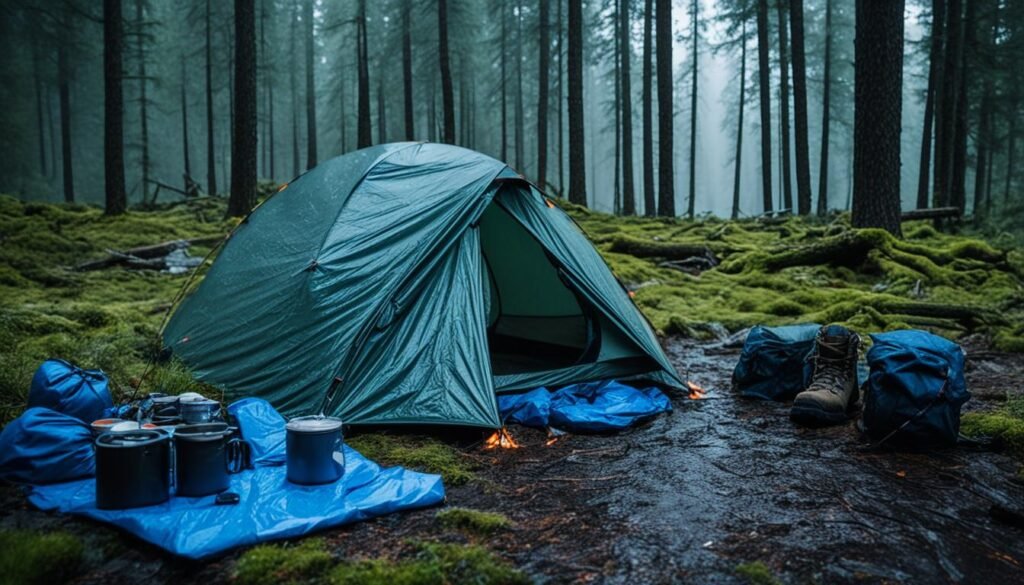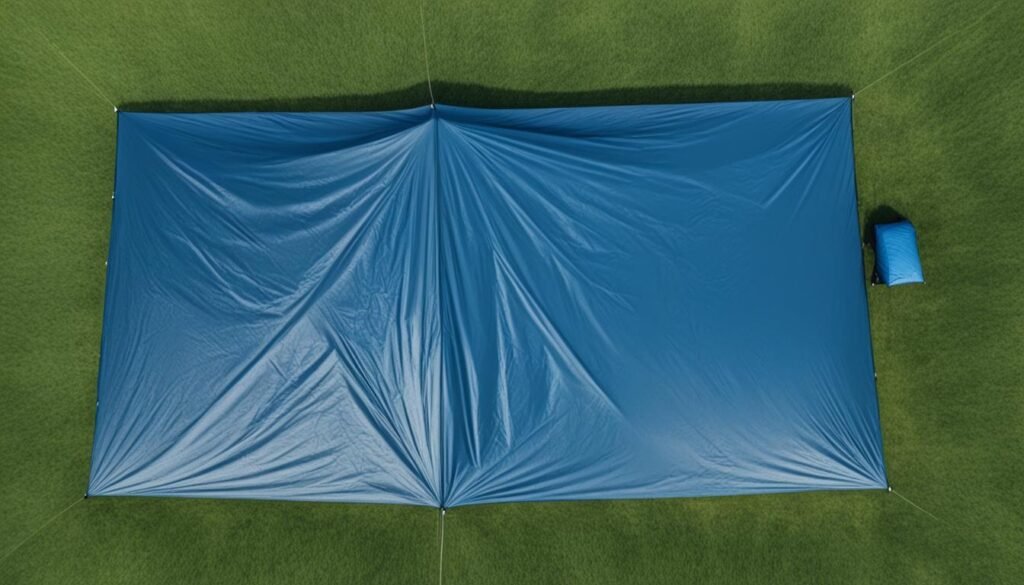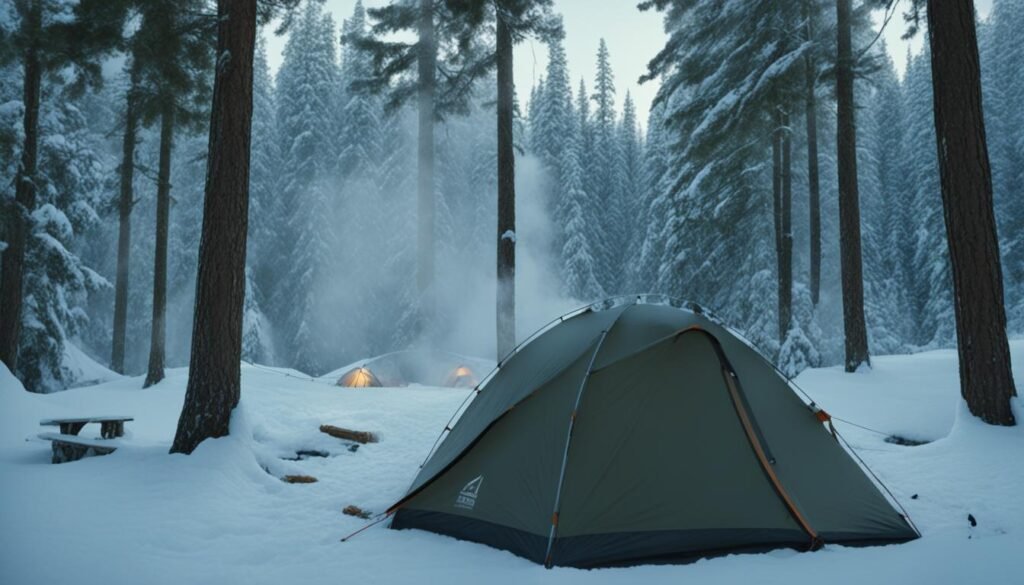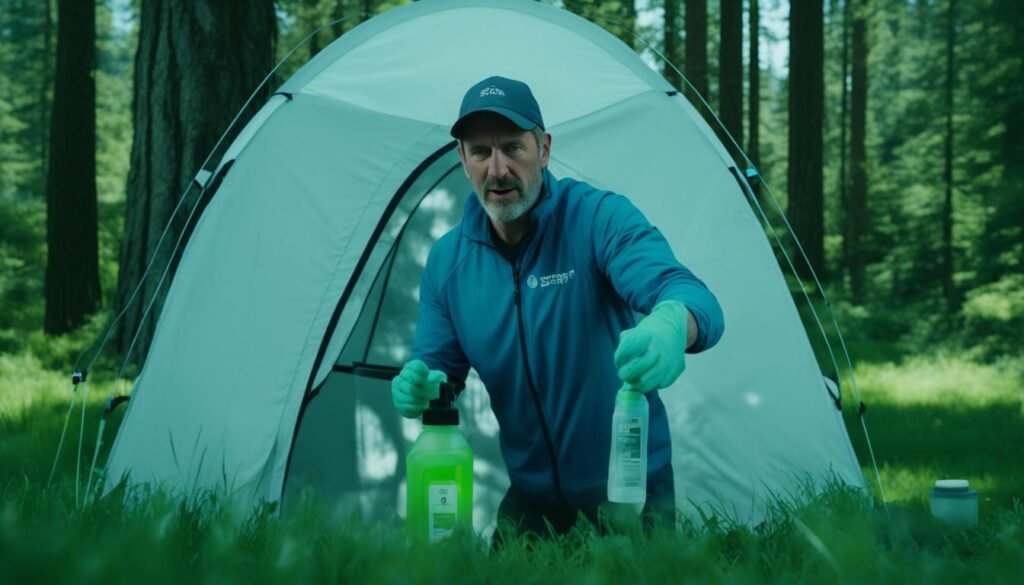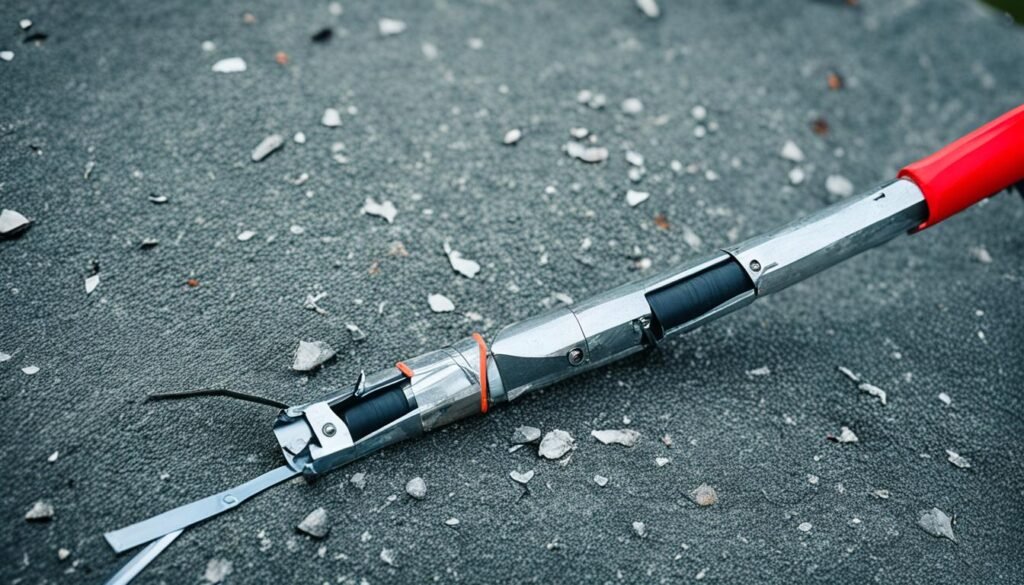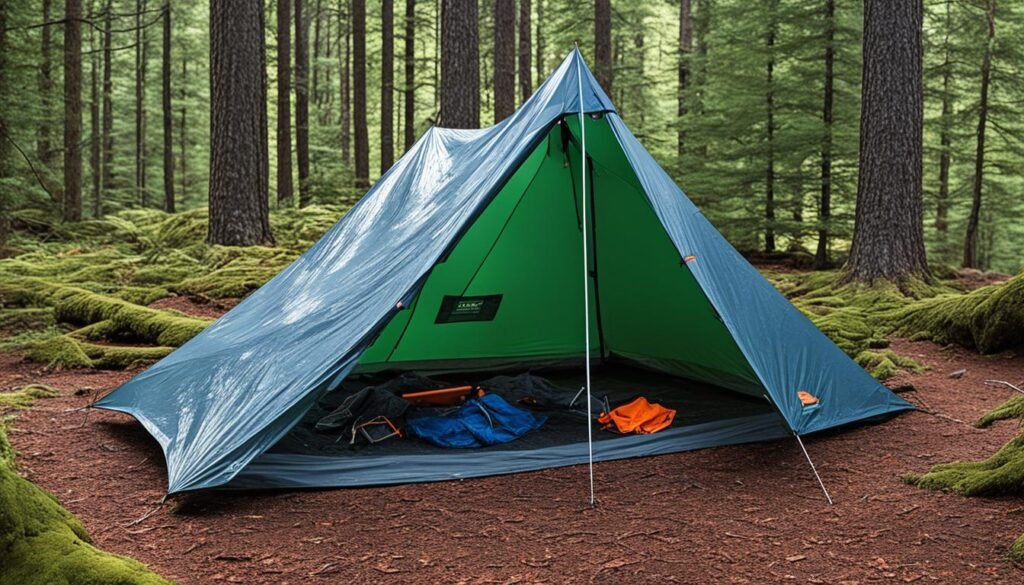Camping in the rain can provide a unique and exhilarating outdoor experience. However, it’s essential to stay dry and comfortable to fully enjoy your camping trip. Knowing how to keep your tent dry in rainy weather is the key to a successful and enjoyable adventure.
In this article, I will share seven strategies that will help you achieve a dry tent even in the heaviest of rains. From using a groundsheet to investing in quality rain gear, these tips will ensure your camping experience remains dry and comfortable.
Key Takeaways:
- Use a groundsheet or a tarp under your tent to protect it from water seepage.
- Set up an extra tarp roof above your tent for added protection against rain.
- Plan your campfire location wisely to resist rain and create a dry cooking space.
- Consider the angles of your tent and campfire setup to maximize dryness.
- Try hammock camping as an alternative to avoid ground moisture.
Tip 1: Don’t Forget Your Groundsheet
A groundsheet, also known as a ground cloth, is a crucial accessory for camping in the rain. Made from a waterproof material, a groundsheet serves as a protective layer between the bottom of your tent and the wet ground. By preventing water from seeping into the tent, a groundsheet helps keep your camping experience dry and comfortable.
If you don’t have a dedicated groundsheet, you can use a larger tarp as an alternative. Position the tarp underneath your tent, creating a barrier between the ground and your tent floor. Ensure that the tarp extends beyond the edges of your tent to provide ample coverage. To avoid water pooling, fold the excess tarp under your tent and secure it in place.
Using a groundsheet or a tarp is essential for protecting your tent from water seepage and maintaining a dry camping environment.
Investing in a high-quality groundsheet made from waterproof material is recommended for optimal protection against ground moisture. Look for groundsheet options specifically designed for your tent model or consider a universal size that suits your camping needs.
Benefits of Using a Groundsheet:
- Prevents water from seeping into the tent
- Protects the tent floor from abrasions and punctures
- Creates an additional insulating layer
- Increases the lifespan of your tent
How to Properly Place a Groundsheet:
- Clean the ground of any debris or sharp objects that could damage your tent or groundsheet.
- Unroll the groundsheet and place it inside the tent footprint, aligning the corners.
- Ensure that the groundsheet does not extend beyond the edges of your tent, as this can collect rainwater and funnel it underneath the tent.
- Smooth out any wrinkles or folds in the groundsheet to create a flat surface.
By using a groundsheet or a tarp, you can significantly reduce the risk of water entering your tent through the ground. This simple preventive measure enhances your camping experience by keeping you dry and comfortable, regardless of rainy conditions.
Tip 2: Tarp Up
When it comes to camping in the rain, tarps are an invaluable piece of gear. They provide versatility and additional protection for your tent, keeping you and your belongings dry. To ensure maximum rain protection, follow these steps:
Step 1: String up an Extra Tarp Roof
First, set up an extra tarp roof above your tent. Use paracord or lightweight camping poles to securely attach the tarp. This extra layer will act as a shield against rainwater, directing it away from your tent.
Step 2: Slant the Tarp Downhill
Make sure to slant the tarp in a downhill position. This angle allows water to flow away from your tent, preventing any potential leaks or pooling. Proper angling of the tarp is essential to ensure effective rain protection.
Step 3: Secure the Tarp
Be sure to securely fasten the tarp to prevent it from being blown away by wind or heavy rain. Use sturdy stakes or ropes to keep the tarp in place. A reliable setup will provide an additional barrier against the elements.
By following these steps, you can effectively tarp up and provide your tent with extra weatherproofing. Take a look at the table below for a quick overview of the benefits of tarping up:
| Benefits of Tarping Up | Extra protection against rainwater |
|---|---|
| Improved waterproofing for your tent | |
| Reduces the risk of leaks or pooling | |
| Provides a barrier against wind and rain |
Remember, investing in quality rain gear and taking proper precautions, such as tarping up, will contribute to a dry and enjoyable camping experience. Now, let’s move on to the next tip!
Tip 3: Consider Your Campfire
When camping in rainy weather, having a campfire can provide much-needed warmth and a dry space for cooking. However, it’s important to plan ahead to ensure that your campfire remains usable even in wet conditions.
Start by setting up your campfire before the rain begins. This way, you’ll have a source of heat and a designated cooking space that won’t get wet. Make sure to gather enough firewood and keep it dry by storing it under tarps or in a covered area. This will ensure that you have a readily available supply of dry firewood when you need it.
Speaking of tarps, they can also be used to create additional dry cooking and firewood storage areas near your campfire. Set up tarps around the fire pit to create a sheltered space where you can cook and prepare meals without exposing yourself to rain. Additionally, these tarps can serve as a dry storage area for firewood, keeping it protected from moisture.
If you anticipate heavy rain that might make it difficult to start or maintain a campfire, consider bringing a camping stove as an alternative. This way, you can still enjoy hot meals and have a backup cooking option in case the weather makes starting a fire impossible.
Remember to always prioritize safety and follow any fire regulations or restrictions in your camping area. With a well-planned campfire setup and dry cooking space, you can continue to enjoy the warmth and comfort of a fire even during rainy camping trips.
Tip 4: Angle for the Weather
Setting up your tent correctly can make a significant difference in keeping it dry during rainy weather. Consider these angles and positioning tips to maximize your tent’s protection:
- Set up your tent on a slight angle to allow water to flow by instead of pooling underneath you. This can be achieved by positioning the higher end of the tent slightly uphill or on a small incline.
- Position your campfire on a slight slant to prevent water from pooling underneath the coal bed. This will ensure you have a dry and reliable heat source.
- Secure your tent with guylines and keep them tight to withstand wind. This will prevent the tent from shifting or collapsing in strong gusts.
- Set up your tent entryway facing away from the wind to minimize the chance of rain entering the tent. This will also help maintain good airflow inside.
- Avoid camping close to or below bodies of water to prevent potential flooding. Choose higher ground for setting up your tent to stay safe and dry.
By applying these tent setup strategies, you can significantly reduce the chances of water seeping into your camping shelter and ensure a dry and comfortable camping experience.
Expert Tip:
“Properly angling your tent and positioning it away from wind and bodies of water is crucial for keeping your tent dry in the rain. Paying attention to these details can make all the difference in your camping experience.” – John Thompson, Outdoor Enthusiast
Comparing Tent Angles and Water Pooling
| Tent Angle | Water Pooling |
|---|---|
| Slight angle uphill or on a small incline | Water flows by and avoids pooling underneath |
| Flat or no angle | Higher chance of water pooling underneath |
| Downhill angle | Water accumulates underneath the tent |
Tip 5: Hammock Camp
Hammock camping can be a great option in flood-prone areas or when rain is expected. By using a hammock, you can elevate yourself and avoid ground moisture. Set up a tarp over your hammock to provide additional protection from rain. Hang your gear underneath the tarp using a line of paracord. This method allows you to stay dry even if the ground is covered in water.
Hammock camping provides numerous advantages in wet conditions. Unlike traditional tent camping, hammocks keep you off the wet ground, reducing the risk of water seeping into your sleeping area. The elevation also helps improve airflow, reducing condensation and ensuring a drier environment inside the hammock.
To further enhance rain-prepared camping, setting up a tarp over your hammock is essential. Not only does it provide additional protection from rain, but it also creates a dry space for you to relax and unwind. By properly angling the tarp and securing it, you can ensure that rainwater flows away from your hammock, keeping you dry and shielded from the elements.
Another advantage of hammock camping is the ability to hang your gear underneath the tarp. By using a line of paracord, you can create a makeshift gear locker, keeping your belongings safe and dry throughout the night. This setup is especially useful in flood-prone areas where ground moisture is a concern.
Overall, hammock camping is an excellent choice for rain-prepared camping, offering both comfort and protection in wet conditions. With a well-placed tarp and a secure gear storage system, you can stay dry and enjoy a peaceful night’s sleep, even when camping in flood-prone areas or during heavy rain.
Tip 6: Store Your Gear in Dry Bags
When camping in wet weather, it’s essential to protect your gear from water damage. One of the most effective ways to do this is by using dry bags. These waterproof storage solutions are specifically designed to keep your clothes, electronics, and other belongings dry, even in the harshest conditions.
Investing in a large, well-made dry bag is crucial for ensuring that your items stay safe and dry during your camping trip. Look for dry bags that are made from durable, waterproof materials and have secure closures, such as roll-top or zip-lock mechanisms.
Properly storing your gear in dry bags not only protects your belongings from moisture but also helps organize and keep them easily accessible. Whether it’s your extra clothes, electronics, or camping essentials, using dry bags provides reliable camping gear protection.
To maximize the effectiveness of your dry bags, follow these tips:
- Roll down the top of the bag as tightly as possible to create a watertight seal.
- Avoid overpacking the bags to ensure proper closure and avoid unnecessary strain on the material.
- Consider using different-sized dry bags for better organization and easy access to specific items.
By storing your gear in dry bags, you can have peace of mind knowing that your belongings are protected from water damage and remain dry throughout your camping adventure.
Tips for Using Dry Bags:
“Using dry bags is a game-changer when it comes to camping in wet weather. Not only do they provide excellent waterproof protection for your gear, but they also make it easier to keep everything organized. I never go camping without my trusty dry bags!”
– Emily Richardson, Experienced Camper
Tip 7: Use Quality Rain Gear
When it comes to camping in wet weather, investing in high-quality rain gear is essential. The right equipment can make all the difference in keeping you dry and comfortable throughout your camping trip. Here are a few key items to consider:
- Rain Jacket: A good rain jacket is a must-have for any camper. Look for one that is waterproof, breathable, and durable. It should have a high waterproof rating to ensure maximum protection against rain.
- Waterproof Pants: Along with a rain jacket, waterproof pants are crucial for staying dry in wet conditions. Opt for pants that are made from quality materials and have a waterproof rating that matches your needs.
- Solid Tent: Your tent is your shelter in the rain, so it’s important to choose one that is built to withstand wet weather. Look for a tent with a waterproof rainfly and a sturdy construction. A solid tent will keep you dry and protected from the elements.
Investing in quality rain gear not only ensures your comfort but also provides peace of mind during rainfall. When planning your camping trip, make sure to check the weather forecast and choose gear that can withstand the expected conditions.
Pick a Good Spot
Choosing the right camping location is essential for keeping your tent dry during your outdoor adventure. Here are some factors to consider when selecting a spot:
- Proper drainage: Look for an area with good drainage to prevent water from pooling beneath your tent. This will help ensure a dry and comfortable camping experience.
- Avoid grassy areas: Grass can hold moisture, increasing the risk of a wet tent. Choose a spot away from grassy areas to minimize the chances of water seeping into your tent.
- Avoid proximity to bodies of water: Camping near bodies of water, such as rivers or lakes, can increase the likelihood of your tent getting wet due to splashback or rising water levels. Stay away from these areas to keep your tent dry.
- Good airflow: Select a spot with good airflow to avoid excessive humidity inside your tent. This will help prevent condensation and keep the interior dry.
By considering these factors and carefully choosing your camping location, you can significantly improve the chances of keeping your tent dry and enjoy a comfortable camping experience.
Use a Rain Tarp
When camping in rainy conditions, using a rain tarp can provide valuable additional protection for your tent. A rain tarp acts as a shield against the elements, preventing rainwater from seeping through the tent material and keeping you dry throughout your camping trip.
To ensure proper setup and optimal performance, follow these steps:
- Choose the right size: Select a rain tarp that matches the dimensions of your tent, or opt for a larger tarp to create a larger protective area.
- Positioning: Place the tarp above your tent with the proper angled positioning. The correct angle will allow water to flow off and away from your tent, preventing pooling and leaks.
- Secure it tightly: Use sturdy ropes or bungee cords to tie down the rain tarp securely. This will prevent it from collapsing under the weight of rain and ensure it remains in place during windy conditions.
By following these steps, you can effectively set up a rain tarp to provide the additional protection your tent needs in rainy weather. Remember, a properly positioned and secured rain tarp will help keep your tent dry so you can enjoy your camping experience without worrying about water leakage.
| Advantages of Using a Rain Tarp | Disadvantages of Not Using a Rain Tarp |
|---|---|
| Extra layer of protection against rain and moisture | Increased risk of water leakage into the tent |
| Prevents pooling of water on the tent surface | Potential damage to tent material and gear due to water infiltration |
| Helps maintain a dry and comfortable camping environment | Reduced enjoyment of the camping experience due to wet and damp conditions |
Use a Groundsheet
When camping in wet conditions, it’s essential to take precautions to keep your tent dry. One effective method is to use a groundsheet, a waterproof barrier that prevents moisture from seeping into the tent from the ground. By placing a groundsheet underneath your tent, you create a protective layer that helps maintain a dry interior.
Proper placement of the groundsheet is important for maximum moisture prevention. Make sure the groundsheet is positioned in a way that aligns with the dimensions of your tent, as it shouldn’t extend beyond the tent’s circumference. This ensures that rainwater cannot collect between the tent and the groundsheet, compromising the tent’s dryness.
By using a groundsheet, you create an additional barrier against wet ground, reducing the chances of moisture seeping into your tent. This simple yet effective measure can greatly contribute to keeping your camping experience dry and comfortable.
“Using a groundsheet is an essential step in preventing moisture from ruining your tent. It provides an extra layer of protection and helps keep the interior dry, even in rainy conditions.” – Experienced Camper
| Benefits of Using a Groundsheet | Drawbacks of Not Using a Groundsheet |
|---|---|
|
|
Investing in a high-quality groundsheet is a wise decision to ensure the best moisture prevention for your tent. It is a small yet crucial component that can significantly enhance your camping experience during rainy weather.

Choose the Right Tent
Selecting the right tent is crucial for a dry and comfortable camping experience. When choosing a tent, consider the following factors:
Ventilation
Look for a tent with proper ventilation to minimize condensation. Good airflow helps prevent moisture buildup inside the tent, keeping you dry and comfortable. Tents with mesh panels or vents allow air to circulate, reducing the chances of condensation forming on the tent walls.
Waterproof Designs
Ensure that the tent you choose has waterproof designs and features that can withstand rain. Look for tents made with waterproof materials and sealed seams. This will prevent water from seeping through the fabric and keep you dry even during heavy downpours. A rainfly or a double-wall tent design provides an extra layer of protection against moisture.
Porches for Gear Storage
Consider tents with porches or vestibules for storing wet gear and providing extra dry space. These additional areas outside the main tent provide sheltered storage or cooking space, keeping your gear dry and easily accessible. Porches are especially useful during rainy weather when you need to keep your wet gear separate from the sleeping area.
By choosing a tent with proper ventilation, waterproof designs, and porches or vestibules for gear storage, you can ensure a dry and comfortable camping experience.
Don’t Spill Anything
Preventing moisture buildup is crucial for keeping your tent dry during camping trips. One way to achieve this is by avoiding storing damp items inside your tent. Moisture from wet items can lead to condensation and make your tent feel damp and uncomfortable.
To prevent moisture buildup, it’s recommended to dry wet items outside the tent. You can utilize the porch area of your tent or hang them on a line outside to let them air dry. Another option is to store wet items in a waterproof bag to keep any moisture contained.
“Properly storing wet items outside the tent helps maintain a dry and comfortable camping experience.”
When it comes to cooking, it’s best to do so outside the tent. Cooking inside can create excess humidity and increase the risk of moisture buildup. Utilize a camping stove or set up a designated cooking area away from your tent to avoid introducing moisture into the tent.
In addition to avoiding spills during cooking, spills in general should be minimized to prevent moisture accumulation. Clean up any spills immediately and ensure the area is thoroughly dried to maintain a dry tent environment.
By taking these precautions and avoiding storing damp items inside your tent, cooking outside to prevent excess humidity, and minimizing spills, you can effectively prevent moisture buildup and keep your tent dry and comfortable during your camping adventures.
Use a Microfiber Towel
Carrying a microfiber towel can be incredibly useful when it comes to keeping your tent dry. Microfiber towels are designed to absorb moisture effectively, making them perfect for wiping down condensation inside the tent. The ultra-fine fibers of a microfiber towel allow for superior absorption, ensuring that every surface is thoroughly dried.
Unlike other towels, microfiber towels can be wrung out multiple times, allowing you to remove as much moisture as possible. This not only helps prevent dampness and mold growth but also contributes to a more comfortable camping experience overall.
To effectively prevent condensation, use the microfiber towel to wipe down both the interior and exterior of the tent. Pay close attention to areas where moisture tends to accumulate, such as the tent walls, rainfly, and seams. By doing so, you’ll significantly reduce the amount of condensation inside the tent, keeping it dry and comfortable.
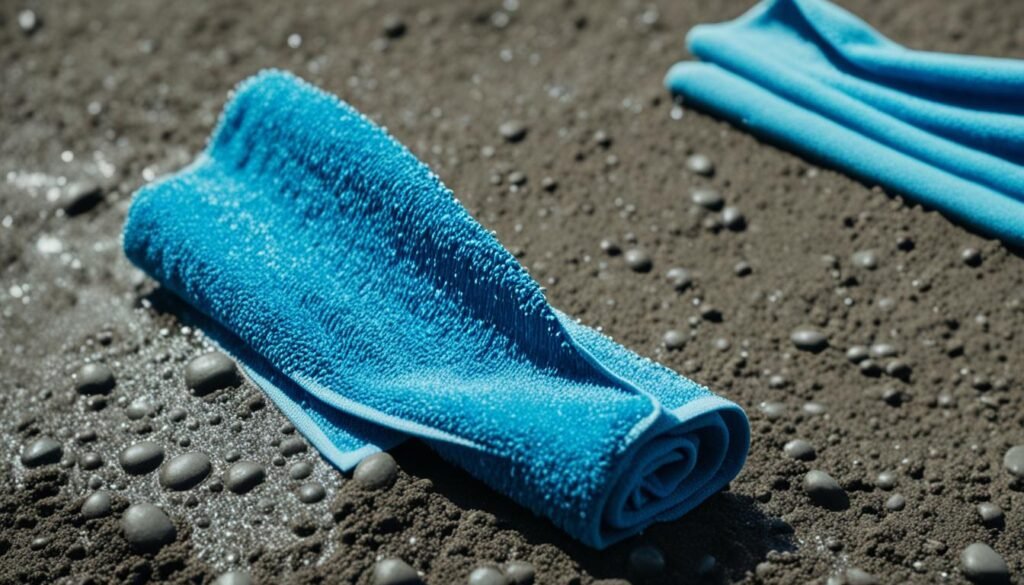
Benefits of Using a Microfiber Towel:
- Highly absorbent: Microfiber towels can absorb several times their weight in water, making them perfect for drying condensation inside the tent.
- Quick-drying: Microfiber towels are designed to dry quickly, allowing you to reuse them multiple times throughout your camping trip.
- Compact and lightweight: Microfiber towels are lightweight and easy to pack, taking up minimal space in your camping gear.
- Durable and long-lasting: Microfiber towels are known for their durability, ensuring that they will withstand frequent use and washing.
By using a microfiber towel, you can effectively prevent condensation and maintain a dry and comfortable environment inside your tent. So, don’t forget to pack one for your next camping adventure!
Ventilate
Proper ventilation is crucial for maintaining a dry and comfortable environment inside your tent. By ensuring proper airflow and tent orientation, you can prevent condensation buildup and enjoy a more pleasant camping experience.
To optimize tent ventilation, position the tent’s door in the direction of the wind. This allows fresh air to enter the tent and promotes airflow throughout the interior. If possible, choose a campsite that provides a natural breeze to enhance ventilation.
Additionally, open all rainfly vents in your tent, especially those that are not directly facing the wind. This allows for cross ventilation and the expulsion of humid air. By creating a continuous airflow, you can minimize condensation and keep your tent dry.
Proper tent orientation is also important for maximizing ventilation. Place your tent in such a way that the prevailing winds can flow through the vents and effectively circulate air inside. Avoid obstructing the vents with any external objects or excessive rainfly coverage.
“Adequate ventilation is the key to combating condensation and maintaining a dry environment inside your tent.”
| Ventilation Tips | Benefits |
|---|---|
| Position the tent’s door facing the wind | Promotes airflow and fresh air circulation |
| Open all rainfly vents, especially those not facing the wind | Allows for proper circulation and expulsion of humid air |
| Ensure tent orientation allows prevailing winds to flow through the vents | Facilitates optimal airflow and minimizes condensation |
By following these ventilation tips and allowing for proper airflow inside your tent, you can significantly reduce condensation and maintain a dry and comfortable camping experience.
What Are the Best Strategies for Waterproofing and Keeping Your Tent Dry in Rain?
When it comes to keeping your tent dry during rainy weather, it’s important to invest in a high-quality waterproof tent. Additionally, using a ground tarp underneath the tent can provide an extra layer of protection. Applying seam sealer to the tent’s seams can also help in keeping your tent dry.
Conclusion
When it comes to camping in the rain, proper preparation is key to staying dry and making the most of your outdoor adventure. By following the tips and strategies outlined in this article, you can ensure a comfortable and rewarding camping experience, even in wet weather.
First and foremost, selecting the right camping spot is crucial. Choose an area with good drainage to prevent water from pooling beneath your tent and avoid grassy areas that can hold moisture. Proper airflow is also important, so camp away from bodies of water and consider the direction of the wind to position your tent for optimal ventilation.
Equipping yourself with the right gear is another essential aspect of staying dry while camping in the rain. Invest in high-quality rain tarps and groundsheets to provide an extra barrier against moisture. Additionally, a well-designed tent with proper ventilation and storage features can greatly enhance your camping experience.
Remember to pack dry bags for storing your gear, use a microfiber towel to prevent condensation buildup inside the tent, and cook outside to minimize humidity. By implementing these strategies and being prepared for rain, you can enjoy a dry and comfortable camping trip regardless of the weather conditions.
FAQ
What is a groundsheet and why is it important?
A groundsheet, also known as a ground cloth, is a waterproof material that protects the bottom of your tent from water seeping in from the ground. It is important for keeping your tent dry while camping in the rain.
How can I set up an extra tarp roof above my tent?
To set up an extra tarp roof above your tent, you can string up a tarp using paracord or lightweight camping poles. Make sure to slant the tarp downhill to allow water to flow away from your tent.
What should I consider when planning my campfire?
When planning your campfire during rainy weather, it is important to choose a location that can resist rain. Set up tarps near the campfire to create additional dry cooking and firewood storage areas.
How should I angle my tent and campfire to prevent water pooling?
To prevent water pooling, set up your tent on a slight angle to allow water to flow by instead of pooling underneath you. Position your campfire on a slight slant to prevent water from pooling underneath the coal bed.
Why should I consider hammock camping in wet weather?
Hammock camping can be a great option in flood-prone areas or when rain is expected. By using a hammock, you can elevate yourself and avoid ground moisture. Set up a tarp over your hammock to provide additional protection from rain.
How can I keep my gear protected from the rain?
To keep your gear dry, use dry bags. These waterproof bags provide protection for your clothes, electronics, and other belongings. Properly storing your gear in dry bags will contribute to a dry and comfortable camping experience.
What rain gear should I invest in for camping in wet weather?
Investing in high-quality rain gear is essential for staying dry. Look for waterproof pants, a good rain jacket, and a solid tent with waterproof designs and features. Investing in quality gear will provide peace of mind and keep you comfortable during rainfall.
How can I pick a good camping spot to keep my tent dry?
When choosing a camping spot, look for proper drainage to prevent water from pooling beneath your tent. Avoid grassy areas, camping close to or below bodies of water, and choose a spot with good airflow to avoid excessive humidity.
How can I use a rain tarp to keep my tent dry?
Using a rain tarp provides an extra layer of protection for your tent. Make sure to properly set up and angle the tarp to allow water to flow off and away from your tent.
Why should I use a groundsheet underneath my tent?
Placing a groundsheet underneath your tent helps prevent moisture from seeping into the tent from the ground. It acts as a barrier against wet ground and helps keep your tent dry.
What should I consider when choosing a tent to keep it dry?
To keep your camping experience dry, look for a tent with proper ventilation to minimize condensation. Choose a tent with waterproof designs and features to withstand rain. Consider tents with porches or vestibules for storing wet gear and providing extra dry space.
How can I prevent moisture buildup inside my tent?
To prevent moisture buildup inside your tent, avoid storing damp items inside. Dry wet items on the tent’s porch or place them in a waterproof bag. Cook outside the tent to avoid creating excess humidity and spills should also be avoided.
How can a microfiber towel help prevent condensation inside the tent?
Carrying a microfiber towel can be helpful for wiping down condensation inside the tent. The towel absorbs moisture effectively and can be wrung out multiple times. Use the towel to wipe down both the interior and exterior of the tent to prevent dampness.
Why is proper ventilation important for keeping the tent dry?
Proper ventilation is crucial for preventing condensation inside the tent. Position the tent’s door in the direction of the wind to encourage airflow. Open all rainfly vents to allow for proper circulation and the expulsion of humid air. Adequate ventilation helps maintain a dry and comfortable environment inside the tent.
How can I stay dry while camping in the rain?
By following the tips and strategies mentioned, such as using a groundsheet, setting up a tarp roof, choosing the right camping spot, and using quality rain gear, you can keep your tent dry and enjoy a rewarding camping experience even in wet weather.

